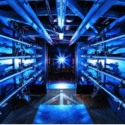[dropcap size=big]V[/dropcap]irtually limitless energy and a world freed from scarcity has been the dream of human kind for millennia. In the mid 20th century this hallowed dream saw a potential reality emerge when the principle of fusion which powers every star in the universe was reproduced in the hydrogen bomb. For over 60 years research delved into sustained ‘fusion power’ which was theoretically capable of producing orders of magnitude more power than current technologies like coal and gas – but with no pollution, radioactive waste or dangerous carbon emissions.
Crash course on fusion energy.
Fusion is the process whereby the atomic nuclei of lighter elements are combined to make heavier elements. So sticking two deuterium atoms together (deuterium is a form of hydrogen with a neutron and a proton) will give you helium and 3MeV (480×10-15J) of energy. To put that in perspective, one gram of deuterium will provide 144 billion Joules of energy when it is completely burned into helium. One gram of benzene, a common hydrocarbon, releases just 48kJ when oxidized (burned in the normal sense). The tremendous ‘harnessed’ heat of these fused nuclei could then be converted to electricity with only the production of the harmless inert gas helium as a byproduct. No climate altering gas’s or toxic radioactive wastes – just copious amounts of clean green energy.
[pullquote] “What we want to do is use the X-rays to blast away the outer layer of the capsule in a very controlled manner, so that the D-T pellet is compressed to just the right conditions to initiate the fusion reaction.”[/pullquote]
Fricking lasers
The most recent and also highly expensive attempt to realise this dream is the National Ignition Facility. Located in the Lawrence Livermore National Laboratory in Livermore California, the NIF has had its share of ups and downs since its construction began in 1997. It seemed that the project from its very inception struggled with adversity and multiple delays during its construction. By the 31st of March 2009, when it was finally completed, the NIF was over five years behind schedule and was punctuated by an eye watering four hundred percent cost blow out.
Indeed Bill Sweet from Spectrum wrote in 2012 that “…the National Ignition Facility (NIF) deserves to be recognized as perhaps the biggest and fattest white elephant of all time.” Further, its secondary reason for existence as a facility to test nuclear warhead efficiencies was also under serious question by Richard Garwin, who had been for decades the most highly regarded independent specialist on nuclear weaponry in the United States. Years behind scehdule for a net gain in an inertial contained fusion reaction the NIF fate, in relation to the already under construction ITER projects, was looking increasingly bleak.
The goal of the NIF was to achieve fusion much like the fusion found in the core of stars and our sun. To reach ignition which can be defined as the point at which the fusion reaction produces more energy than is needed to initiate it, the NIF focuses 192 laser beams simultaneously in billionth-of-a-second pulses inside a cryogenically cooled hohlraum (from the German word for “hollow room”), a hollow cylinder the size of a lipstick container. Within the hohlraum is a ball-bearing-sized capsule containing two hydrogen isotopes, deuterium and tritium (D-T). The unified lasers deliver 1.8 megajoules of energy and 500 terawatts of power. An amount 1,000 times greater than the United States power grid uses at any one moment. This concentrated laser power was delivered to the hohlraum creating an “X-ray oven” which implodes the Deuterium/Tritium fuel capsule to temperatures and pressures similar to those found at the center of the sun.

John Edwards, NIF associate director for inertial confinement fusion and high-energy-density science for the NIF explains,
“What we want to do is use the X-rays to blast away the outer layer of the capsule in a very controlled manner, so that the D-T pellet is compressed to just the right conditions to initiate the fusion reaction.”
The NIF by mid 2013 had met many of the requirements believed necessary to achieve ignition – sufficient X-ray intensity in the hohlraum, accurate energy delivery to the target and desired levels of compression – but at the time at least one major hurdle remains to be overcome, the premature breaking apart of the capsule.
At almost the eleventh hour in October of 2013, the NIF achieved its first milestone when the capsule was consumed evenly on schedule without a premature disintergration. Up till then this was the biggest failing of the NIF process. Its second big achievement was achieved in February of 2014 when the NIF was briefly able to liberate almost twice the amount of energy than was used to ignite the D-T fuel capsule. This net gain had stunning significance for both the program and for Fusion power in general and was achieved by using 192 lasers simultaneously striking a small spherical pellet of only a few milligram mix of deuterium and tritium. The 500 terrawatt combined laser beams hit the pellet over its entire surface within pico seconds of each other and creates a plasma field on the pellets surface generating enormous thermally generated pressure. This compresses the lower layers of the pellet until eventualy the fuel mass fuses and releases vast amounts of energy. It also functions to create a compression field utilizing the principle of inertial confinement to sustain the fusion reaction to produce a stable energy source.
The researchers moved with urgency to clarify that this was still not completed fusion, as only approx 1% of the 192 lasers generated actually made it into the fuel. The NIF team leader told reporters in a press briefing on Monday that this latest milestone is “kind of a major turning point in a lot of our minds.”
The results are published this week in a paper in Nature. (NIF made a similar announcement in August last year, when some 8000 joules of energy were released in the form of neutrons. In this paper however, the NIF team reports yields as high as 17000 joules which moves the reaction into a very clear net gain.) Another perhaps more important breakthrough was the detection of Alpha particle heating in this later reaction where the fusion generated helium atoms leave thier energy in the fuel rather than in an energy scatter away from the fuel. This alpha particle heating is a vital feature of bootstrapping this process into a ‘sustained fusion’ where an initial fusion triggers a chain reaction and becoming actual ‘fusion ignition’.
Realistically the NIF is a a long way from actual fusion with the 8000 joule net gain for its last laser shot equal to about 2 food calories (the amount of energy you’d get from eating an eighth of a teaspoon of sugar) Its total energy yield from the lastest ‘shot’ still only produces about 1 percent of the mass conversion to energy required for fusion ‘ignition’. So the challenges facing the NIF in order to achieve ‘ignition’ are still considerable. Far more energy from the laser blasts would need to strike the fuel pellet at an estimated 30 to 40 shots per day (instead of the current two shot max per day) in order to maintain an actual net energy producing fusion reaction using inertial confinment.
And in the red corner
However there is a competing Fusion power program using a different principle pioneered by the initially Russian Tokamak technology called magnetic containment. This involves heating gaseous fuel puffed in a vaccum chamber to 100 million degrees. Then attempting to contain and sustain the resulting fusion explosion in powerful cross linked vertical and horizontal magnetic fields that are generated by toriodal and poliodal magnetic coils. These fields, requiring very large energy inputs, are essential to cage and shape the fusion reaction, keeping the ultra hot plasma away from the reactor walls as the hot gas expands rapidly. Very powerful magnetic fields are required to force the plasma back together.

The ITER project is supported by 34 nations including the USA which does seem to be hedging its bets on fusion technology by pouring billions into both programs. A test reactor is currently under construction in Cardarache France to create an experimetal model to produce sustained fusion. Until ITER is completed in 2020 and runs full power tests in 2028, the Joint European Torus located at Culham Centre for Fusion Energy, is currently the largest and most powerful tokamak currently operating. This has achieved much higher yields from the magnetic containment system and longer sustained reactions. In 1997, JET briefly produced 16 megawatts of power from a total input power of 24 megawatts. In other words, it got 65 percent of the way to ignition, compared to 1 percent for the National Ignition Facility. Recently in 2013 the EAST reactor in Heefie China managed a tenfold increase in the time it was able to contain the reacting plasma. As described by J. Li and colleagues, the latest run at EAST achieved a plasma pulse lasting over 30 seconds which is a record achievement that simultaneously demonstrated improvements in heat dispersal.
Nuclear fusion generates enormous heat as it overcomes the electrical polarity of particles crammed together into the magnetic fields. So significant improvements in heat dispersal is yet another recent breakthrough in this process. The under construction ITER rector is designed to produce approximately 500 MW of fusion power sustained for up to 1,000 seconds, though it will not be converting the generated heat energy to electricity. Yet the ITER project also face’s some major hurdles including developing technology not yet available. An example is superconducting magnets and robotic systems for internal Tritium reactor breeding processes to use to more efficient use fuel of which there is a very limited supply on Earth. Other options include mining the moon where large deposits of tritium are possibly available. But the very difficult task of breeding the element itself through particle interactions in the rector itself is still the more practical and certainly a cheaper option for sourcing Tritium. The next step on the way to commercial fusion power, the DEMO reactor which will replace the ITER, will need about 300g of tritium per day to produce 800 MW of electrical power. No known sufficient external source of tritium exists for fusion energy development beyond ITER, which makes the successful development of tritium breeding essential for the future of fusion energy.
Fusion on the cheap?
Aside from the fusion front runners is General fusion or magnetically targeted fusion that is currently being developed by a company of the same name, General Fusion. Based on technology going back to the1970s US Naval research, Magnetised Target Fusion utilises compressed gas and thick liquid metal walls to contain short lived reactions that promise net energy gains with every short pulse. MTF creates a fusion reaction that gives off more energy than is needed to trigger it – using relatively low-tech, mechanical brute force and advanced digital control technologies which scientists could only dream of 30 years ago. The prototype reactor will be composed of a metal sphere about three meters in diameter containing a liquid mixture of lithium and lead. The liquid is spun to create a vortex inside the sphere that forms a vertical cavity in the middle. Two donut-shaped plasma rings, themselves held together by self-generated magnetic fields, called spheromaks, are injected into the cavity from the top and bottom of the sphere and come together to create a target in the center. “Think about it as blowing smoke rings at each other,” says Doug Richardson, chief executive of General Fusion.
The shell of the metal sphere has 220 pneumatically controlled pistons porcupining it with each one programmed to simultaneously ram the surface of the sphere at 100 meters a second. The force of the pistons sends an acoustic wave through the lead-lithium mixture, and that accelerates into a shock wave as it reaches the plasma, which is made of the hydrogen isotopes deuterium and tritium. The initial goal of this is to create a short lived but sustained plasma instantly fusing the ‘target’ tritium and deuterium isotopes into helium. This subsequently floods the liquid lead/ lithium molten shell with a torrent of energy charged nuetrons. Heat exchanges could then create steam to drive a turbine and generate electricity. The long term goal is to be able to repeat this process by injecting target fuel isotopes and then compress them to plasma every second and harvesting a stacatto burst of heat therefor powering the turbine.

This comparatively low cost option seems at first very attractive, especially considering the ongoing 20 billion dollar plus price tag of the ITER project and close to half that for the NIF. It seems especially attractive to some, with niether of the larger projects yet delivering sustained fusion as they rack up millions of dollars of costs per month in their pursuit of this chimerical technology. If successful, General Fusion believes it can build a grid-capable fusion reactor rated at 100 megawatts four years later for about $500 million. This beats ITER by about 20 years and at a fraction of the cost. Some of the United States most qualified fusion experts say that the approach General Fusion has taken to magnetized target fusion, is scientifically sound and could actually work. “I’m rooting for them,” says Ken Fowler, professor emeritus of nuclear engineering and plasma physics at the University of California, Berkeley, and a leading authority on fusion-reactor designs. His analysis of General Fusions approach discovered no major technical hurdles or impossibilities.“Maybe these guys can do it. It’s really luck of the draw.”
Glen Wurden, program manager of fusion energy sciences at Los Alamos National Laboratory and an expert on magnetized target fusion, says General Fusion has a challenging road ahead and has many practical questions to answer definitively. He asks if they can produce spheromaks with the right densities, temperature, and life span? Can they inject two spheromaks into opposite ends of the vortex cavity and make sure they collide and merge? Will the acoustic waves travel uniformly through the liquid metal?
Some experts however, are more fervent in thier scepticism of the project. Canada’s leading particle physicist, Erich Vogt, is unapologetically damning in his criticism, which appeared in a journal, Physics in Canada, two years ago. Eric Vogt is Professor emeritus at the University of British Columbia and the founder of TRIUMF, Canada’s national laboratory of nuclear and particle physics in Vancouver. The Order of Canada recipient labelled General Fusion’s approach as “Cloud Cuckooland” and “unproven science in the guise of technology development.”
A significant amount of the future testing the MTF will need, can not be adequatley done in computer modelling, but requires actual physical testing. Funding is currently thin on the ground with the two large Fusion projects already siphoning off available funds and an unsteady domestic eocnomy in the United States. General Fusion took over 4 years longer than planned to raise the 13.5 billion it needed to fund this developement and its likely further funding will be even more problematic. Recently in Physical Review Letters, 2012, DOI: 10.1103/PhysRevLett.108.025003 researches have suggested combining the two technolgies of the NIF and ITER rather than pursue singular approach to the conundrum of sustained fusion power. Their paper theorises combining laser intertial confinement with powerful magnetic fields to solve the deficits in each system.
Confused yet?
In Summary it seems that the current multi modal approach to the Fusion conundrum after decades in relative stasis seems in light of multiple recent breakthroughs to be making some very real ground towards this holy grail of both science and industry. Perhaps one or all of these aproaches to fusion may yield fruit. Possibley none will strike gold individually, but via a hybrid of methodologies which may emerge success. Perhaps the first commerical proof of this will in occur in 2028 with ITER or even sooner with the NIF or General fusions MTF. But buried in all this dreaming, speculation and extrapolation is one very certain truth. In a world ailing from current power generation technologies, biospheric pollution and an ever increasing demand for electrical power, Fusions promise of a power generating gold age cannot come soon enough.
Follow Circus Bazaar on Facebook
Follow Circus Bazaar on Twitter
Subscribe to us on YouTube




























